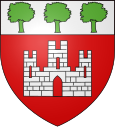Villetaneuse
| Villetaneuse | ||
|---|---|---|

|
|
|
| region | Île-de-France | |
| Department | Seine-Saint-Denis | |
| Arrondissement | Saint-Denis | |
| Canton | Épinay-sur-Seine | |
| Community association |
Métropole du Grand Paris and Plaine Commune |
|
| Coordinates | 48 ° 58 ′ N , 2 ° 21 ′ E | |
| height | 34-85 m | |
| surface | 2.31 km 2 | |
| Residents | 13,646 (January 1, 2017) | |
| Population density | 5,907 inhabitants / km 2 | |
| Post Code | 93430 | |
| INSEE code | 93079 | |
| Website | http://www.plainecommune.fr/ | |
 New town hall of Villetaneuse under construction |
||
Villetaneuse is a French commune in the Seine-Saint-Denis department with 13,646 inhabitants (as of January 1, 2017). The city is about six kilometers north of the Paris city limits .
Its inhabitants call themselves Villetaneusien (ne) s .
Neighboring communities
Villetaneuse is bounded by the communes of Saint-Denis , Épinay-sur-Seine , Pierrefitte-sur-Seine and Montmagny in the Val-d'Oise department .
history
Origin of name
Villetaneuse was mentioned several times in different forms: Villa Tineosa around 1120, Villa Teignosa 1209, Villa Teigneuse 1313, Villa Scabiosa 15th century, Ville Tigneuse 1470, Ville-taneuse 1517.
The name of the village was probably derived from Villa Tine Osa (the place where people who Lohe treated to hides to tan) or by Villa stagnosa (area of the ponds).
development
The first mention of Villetaneuse is confirmed around 1120 by Ricardus of Villatenosa. The fief of Villetaneuse then falls under both the Lord of Montmorency and the Abbot of Saint-Denis.
At the beginning of the 15th century, the collegiate church of Saint-Martin de Montmorency owns vineyards in Villetaneuse, hence the tax rights. In the 16th and 17th centuries, the lords of Villetaneuse were royal officers like Jean des Vivier, lawyer in parliament in 1650, Julien Chauveau, prosecutor in parliament in 1588.
A charter from 1613 states that Anne Robert, a lawyer in Parliament, lord de Villetaneuse, then resident in Paris, and Jacques Doublet, monk in Saint Denis, exchange the rights they have over Pierrefitte and Villetaneuse. 1658 a county is established in Villetaneuse, which also includes Briche and Épinay.
The parish of Saint-Liphard was founded in the 13th century.
From 1463 on, the gypsum quarries of Villetaneuse are mentioned, which together with agriculture represent the main wealth of Villetaneuse. In 1783 the police lieutenant punished stone breakers who mine the gypsum stone without permission.
A castle is included in the maps of the old regime, but in 1825 the mayor's card highlights that only the park remains of the castle. The park of this castle was converted into an industrial zone in the 19th century and became the origin of the Villetaneuse industrial area.
Population development
| year | 1962 | 1968 | 1975 | 1982 | 1990 | 1999 | 2006 | 2017 |
| Residents | 4,892 | 7,405 | 8,909 | 10,080 | 11,177 | 11,376 | 11,887 | 13,646 |
Town twinning
- Vila Nova de Foz Côa , Portugal
- Birkenwerder , Germany
traffic
Villetaneuse does not have its own connection to the metro or train. The nearest train station is Épinay - Villetaneuse on the Transilien Paris - Nord suburban line. But there are several bus routes.
Personalities
- César (1921–1998), sculptor, had his studio in the community. His Venus de Villetaneuse is on display in front of the town hall.
- Maurice Utrillo (1883–1955), painter, lived in Pierrefitte-sur-Seine and has shown in particular the church of Villetaneuse and the Château de Villetaneuse .
- Martial Trico, singer of the group Manau .
- Maurice Grandcoing, communist resistance fighter. Shot in Mont Valérien on August 11, 1942 .
literature
- Le Patrimoine des Communes de la Seine-Saint-Denis. Flohic Éditions, 2nd edition, Paris 2002, ISBN 2-84234-133-3 , pp. 415-417.
